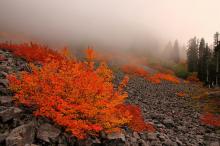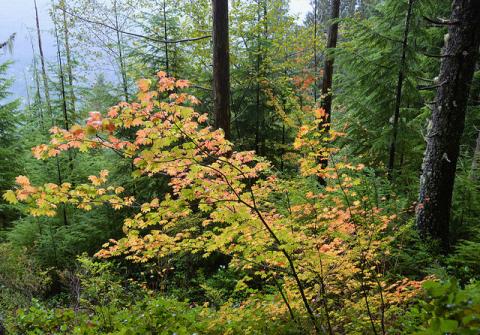
Image Credit: Oregon Department of Transportation
Family: aceraceae (maple)
Common name(s): Vine maple
General bloom time: late April-June, tree will flower; fruit ripens in late September or October; seeds disperse throughout November
Identification: deciduous shrub or small tree; n reach nearly 30 feet in height
Leaves: opposite growing leaves with 7-9 toothed lobes; lower surface of the leaves are furry with the upper area only furry along the veins; may turn a golden color in the autumn
Fruit: winged and spread in a widely shaped pair
Habitat: prefers moist shady areas but tolerates sun; nitrogen rich, well-drained soils; ranges from mid to high elevations
Ecology: Vine Maple is found in many ecotypes and provides a bounty of edibles for wildlife. The seeds, buds and flowers are nutriment for song birds, game birds, and mammals. Deer and elk forage on the leaves and bark; elk continue feeding on the buds and bark in the barren winter. The simple flowers provide nectar for bees and butterflies. The leaves are fodder for brown tissue moth and polyphemus moth larvae. Birds may gather Vine Maple’s leaves and stems for nesting materials.

Image Credit: Jessie Hey
Fun Facts:
- Early trappers called it ‘devil wood’
- The bark is sometimes boiled to make a tea useful in fighting the common cold
Places to find in Portland: Forest Park
References: Campbell, Alsie Gilbert; Franklin, Jerry F. 1979. Riparian vegetation in Oregon’s western Cascade Mountains: composition, biomass, and autumn phenology. Bull. No. 14. Seattle, WA: U.S./International Biological Program, University of Washington, Ecosystem Analysis Studies, Coniferous Forest Biome. 90 p. [8433]
http://www.fs.fed.us/database/feis/plants/shrub/acecir/all.html